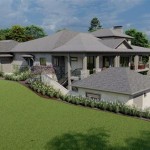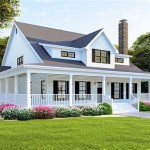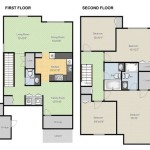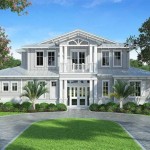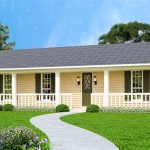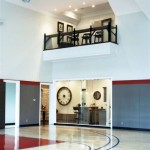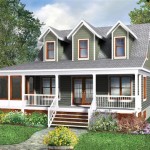Best Floor Plans for 5-Bedroom Homes
The acquisition of a 5-bedroom home represents a significant investment and a commitment to accommodating a larger household, extended family, or the pursuit of specialized living spaces. Selecting the optimal floor plan is paramount to ensuring comfort, functionality, and long-term satisfaction within the home. This article explores various 5-bedroom floor plan designs, emphasizing key considerations and highlighting features that enhance overall livability.
The ideal floor plan depends heavily on individual needs and lifestyle. Factors such as the age and mobility of occupants, the frequency of entertaining, the requirement for dedicated workspaces, and the preferred level of privacy all influence the most suitable design. Understanding these preferences is critical before evaluating specific floor plan options.
Evaluating Lifestyle Needs and Preferences
Before diving into specific floor plan layouts, it is crucial to assess the lifestyle of the inhabitants. Consider the daily routines of each family member. Do multiple individuals require simultaneous access to bathrooms during peak hours? Are there any occupants with mobility limitations that necessitate a single-story design or specific accessibility adaptations? How frequently do you entertain guests, and how will the floor plan facilitate this activity? Answering these questions will guide the selection process and prioritize features that directly enhance the daily lives of the homeowners.
Furthermore, determine the desired degree of separation between living areas and sleeping quarters. Some families prefer an open-concept design that fosters interaction and connectivity, while others prioritize privacy and seek a more compartmentalized layout. The presence of children is a significant factor. A floor plan that places bedrooms in close proximity to the master suite can provide peace of mind for parents of young children. Conversely, older children may appreciate a greater degree of separation and independence.
Finally, consider the long-term needs of the family. Will the household grow in the future? Is there a possibility of needing to accommodate elderly parents or adult children returning home? A flexible floor plan that can adapt to changing circumstances is a valuable asset. This might involve selecting a design that includes a bonus room or a finished basement that can be converted into additional living space as needed.
Common 5-Bedroom Floor Plan Styles
Several distinct floor plan styles cater to the needs of 5-bedroom homes. Each style possesses unique characteristics and advantages, so it is essential to understand these differences to make an informed decision:
- Two-Story Floor Plan: This is perhaps the most common layout for 5-bedroom homes, particularly in areas with limited land availability. Typically, the master suite and additional bedrooms are located on the second floor, promoting separation from the main living areas. This design often allows for a larger footprint while maximizing vertical space.
- Ranch-Style (Single-Story) Floor Plan: Ideal for accessibility and aging in place, ranch-style homes offer all living spaces on a single level. A 5-bedroom ranch requires a substantial footprint and may be more suitable for larger lots. The design promotes ease of movement and eliminates the need for stairs, making it an attractive option for individuals with mobility challenges.
- Split-Level Floor Plan: This design features staggered levels, often with the main living areas on one level and bedrooms on another, with a short flight of stairs connecting them. Split-level homes can be aesthetically interesting and can provide a sense of privacy between different areas of the house.
- Cape Cod Floor Plan: Characterized by steep rooflines and dormer windows, Cape Cod homes often feature bedrooms on the upper level under the eaves. This style can offer a cozy and charming aesthetic.
Within these broad categories, further variations exist, incorporating features such as open-concept living, formal dining rooms, home offices, and dedicated recreation spaces. The key is to find a style that aligns with the specific needs and preferences of the homeowner.
Regardless of the chosen style, it's essential to assess the flow of the floor plan. Consider how easily individuals can move from one area to another and whether the layout effectively separates high-traffic zones from quieter, more private spaces. A well-designed floor plan will promote a sense of harmony and functionality throughout the home.
Key Features to Consider in a 5-Bedroom Floor Plan
Beyond the overall layout, several specific features can significantly enhance the functionality and appeal of a 5-bedroom home. Prioritizing these features during the floor plan selection process will contribute to a more comfortable and enjoyable living experience:
- Master Suite Placement and Features: The location of the master suite is crucial. Many homeowners prefer a secluded location away from the other bedrooms, offering a private retreat. Essential features include a spacious bedroom, a walk-in closet, and a well-appointed en-suite bathroom with separate shower and bathtub. Consider the inclusion of a private balcony or sitting area for added luxury.
- Bedroom Size and Layout: Ensure that each bedroom is appropriately sized for its intended use. Children's bedrooms may require ample space for play and study. Guest bedrooms should be comfortable and inviting. Consider the placement of windows and closets to maximize usable space and natural light.
- Bathroom Configuration and Accessibility: The number and layout of bathrooms are critical considerations. A 5-bedroom home typically requires at least three bathrooms to accommodate the needs of a larger household. Consider the possibility of a Jack-and-Jill bathroom connecting two bedrooms. Ensure that at least one bathroom is easily accessible to guests and located near the main living areas. Also, consider future needs for handicap accessibility.
- Kitchen Design and Functionality: The kitchen is often the heart of the home, and its design should prioritize functionality and efficiency. Consider the layout of the kitchen triangle (sink, stove, and refrigerator) to minimize steps and maximize workflow. Ample counter space, storage options, and a well-placed island are essential. For larger families, a double oven or a secondary prep sink may be beneficial.
- Living and Family Room Spaces: Depending on lifestyle, a 5-bedroom home might benefit from having two distinct living areas – a formal living room for entertaining and a more casual family room for everyday use. Consider the placement of these spaces in relation to the kitchen and other living areas. Adequate natural light and comfortable seating arrangements are essential.
- Laundry Room Placement and Features: The laundry room should be conveniently located, preferably near the bedrooms or in a mudroom area. Consider the inclusion of a utility sink, ample counter space for folding laundry, and storage for detergents and supplies. A front-loading washer and dryer can maximize space and improve accessibility.
- Storage Solutions: Adequate storage is essential in any home, but it is particularly important in a 5-bedroom home. Consider the inclusion of walk-in closets, linen closets, pantry space, and garage storage. Maximizing storage throughout the home will contribute to a more organized and clutter-free living environment.
- Outdoor Living Spaces: Extend the living space outdoors by incorporating features such as a patio, deck, or porch. These spaces provide opportunities for relaxation, entertaining, and enjoying the surrounding landscape. Consider the placement of outdoor living spaces in relation to the kitchen and living areas for easy access and flow.
These features collectively contribute to the overall functionality and livability of a 5-bedroom home. By carefully considering these aspects during the floor plan selection process, homeowners can create a space that meets their specific needs and preferences.
In addition to the specific features mentioned earlier, consider the overall flow of the floor plan. How easily can individuals move from one area to another? Does the layout effectively separate high-traffic zones from quieter, more private spaces? A well-designed floor plan will promote a sense of harmony and functionality throughout the home.
Adapting Floor Plans to Specific Needs
While pre-designed floor plans offer a starting point, customization is often necessary to tailor the design to specific needs. Several modifications can be implemented to adapt a floor plan to individual preferences:
- Adding or removing walls: Altering the wall configuration can significantly impact the flow and functionality of the home. Removing walls to create an open-concept living area is a common modification. Conversely, adding walls can create more private spaces or define distinct areas within a larger room.
- Repositioning doors and windows: Relocating doors and windows can improve the natural light, ventilation, and accessibility of the home. Consider the placement of windows to maximize views and minimize glare. Repositioning doors can improve traffic flow and optimize the use of space.
- Converting existing spaces: A bonus room can be converted into a home office, a playroom, or an additional bedroom. A formal dining room can be transformed into a study or a library. The possibilities are endless, depending on the specific needs of the homeowner.
- Adding or modifying bathrooms: Adding an en-suite bathroom to a guest bedroom or creating a Jack-and-Jill bathroom between two children's bedrooms can significantly enhance the functionality of the home. Modifying the layout of an existing bathroom can improve accessibility and maximize space.
- Expanding the footprint: If the lot size permits, expanding the footprint of the home can provide additional living space, creating larger rooms or adding new features such as a home theater or a gym.
When considering modifications to a floor plan, it is essential to consult with a qualified architect or designer. They can provide valuable insights and guidance, ensuring that the modifications are structurally sound and aesthetically pleasing. They can also help navigate any building codes or zoning regulations that may apply.
Adapting a floor plan to specific needs requires careful planning and attention to detail. However, the effort is well worth it, as it allows homeowners to create a space that perfectly suits their lifestyle and preferences.
Ultimately, the best floor plan for a 5-bedroom home is one that aligns with the unique needs, lifestyle, and preferences of its inhabitants. By carefully considering the factors discussed in this article, homeowners can make an informed decision and create a living space that is both functional and enjoyable for years to come. The selection process requires careful consideration of all aspects, ensuring a comfortable and efficient living environment.

House Design Plan 13x12m With 5 Bedrooms Home Building Plans Designs Bungalow Floor 4 Bedroom

490 5 Bedroom House Plans Ideas In 2024

5 Bedroom House Plans Monster

5 Bedroom House Plan Examples

5 Bedroom House Plan Examples

The Best 5 Bedroom Barndominium Floor Plans

5 Bedroom Apartment Plan Examples

Bedroom Ranch House Plans One Den Design Decorating Zen And Designs Luxury 5

10 Inspiring 5 Bedroom House Plans Designs And Layouts In 2024 To Co Ke

Ranch Style House Plan 5 Beds 3 Baths 3821 Sq Ft 60 480 Dreamhomesource Com

